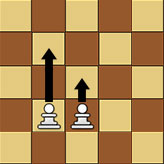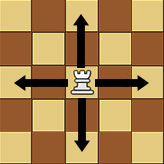
Chess is a game played between two opponents on opposite sides of a board containing 64 squares of alternating colors.
The player using the white pieces moves first in Chess. Players generally decide who will get to be white by chance such having one player guess the color of the hidden pawn in the other player's hand.
Each player is obligated to move on their turn.
There are six kinds of pieces in chess: king, queen, rook, bishop, knight and the pawn.
Setup

The chessboard is laid out so the white color square in the bottom right-hand side.
- The second row is filled with 8 pawns.
- The rooks go in the corners
- then the knights
- then the bishops
- then the queens (white queen on white, black queen on black)
- the king on the remaining square.
Object of the Game
The goal of the game is to checkmate the other king. Checkmate happens when the king is in a position to be captured and cannot escape from capture.
Video Tutorial
Check, Checkmate and Stalemate
A check is an immediate threat to capture the king.
In the following move, the player whose king is in check must get his king out of check.
This can be done by:
- moving the king to a space where the king is no longer in check
- interposing a piece between the threatening piece and the king
- by capturing the threatening piece
If the king is in check and there is no legal move which gets the king out of check, the king is said to be checkmated and the game is over.
The game is drawn when the player to move has no legal move and his king is not in check. The game is said to end in 'stalemate'.
How The Pieces Move
Pawn

Pawns are unusual because they move and capture in different ways. They move forward, but capture diagonally.
Pawns can move only one square forward and may not move backwards.
The first time each pawn is moved from its initial position, it has the option to advance two squares.
Any piece directly in front of a pawn (friend or foe) blocks its advance.
The eight pawns are set on rows two.
The pawn is maybe the least powerful piece in chess, but it can promote to any other piece.
-
Capturing
A pawn captures diagonally one square forward and to the left or right.
-
Promotion
A pawn that advances to the opposite side of the board is promoted to another piece of that player's choice of a queen, rook, bishop, or knight of the same color.
The pawn is immediately replaced by the new piece and the choice of promotion is not limited to captured pieces.
Players may have as many as ten knights, ten bishops, ten rooks or nine queens.
-
En Passant
An even more unusual move is the en passant capture which is French for "in passing".
If a pawn moves out two squares on its first move and lands to the side of an opponent's pawn, that other pawn has the option of capturing the first pawn as it passes by.
This special move must be done immediately after the first pawn has moved past, otherwise the option to capture it is no longer available.
Bishop

The bishop moves diagonal and has no restrictions in distance (1 square, 2 squares, 3 squares, ..)..
The bishop stays always on its starting color, which can be seen as a little weakness.
The bishop is placed on the 3rd and 6th column.
Bishops cannot jump over other pieces (enemy or own pieces).
For: more information about the bishop.
Knight

A knight moves unusal:
- two squares horizontally and one square vertically
- two squares vertically and one square horizontally
The complete move therefore looks like the shape of letter "L".
Knights are placed on the 2nd and 7th columns.
The knight can jump over all other pieces to its destination.
For: more information about the knight.
Rook

The rook moves horizontally or vertically and has no restrictions in distance (1 square, 2 squares, 3 squares, ..)..
Rooks are set on the 1st and 8th column.
Rooks can be powerfull when they protect each other.
Rooks cannot jump over other pieces (enemy or own pieces).
Queen

The queen moves horizontally, vertically and diagonal and has no restrictions in distance (1 square, 2 squares, 3 squares, ..)..
The queen can be seen as the most powerful piece.
The queens are set up on 4th column.
It cannot capture nor move trough a piece on its own side.
King

The king moves horizontally, vertically and diagonal and only 1 square.
A king can also not move onto a square that is threatened by an opponents piece.
The king is the most important piece, when you loose him, you are lost.
The king is placed on the 5th column.
Castling
Castling consists of moving the king two squares toward either one of the original rooks, then moving the rook onto the square over which the king crossed.
Castling is allowed when:
- it must be the king's first move
- it must be the rook's first move
- no squares between them are occupied
- the king is not in check
- he king will not move across or end its movement on a square that is under enemy control.
Draws
Sometimes a chess game don't end with a winner but with a draw.
There are 5 reasons why a chess game may end in a draw:
- both players agree to draw
- there are not enough pieces left to force a checkmate
- the same exact position is repeated 3x times
- no pawn was moved and no piece was captured during 50 consecutive moves
- the game is in stalemate
Time Control
A regular chess clock is used to limit the length of a game.
These clocks count the time that each player separately takes for making his own moves.
If you run out of time, you lose the game.
Continue Reading


